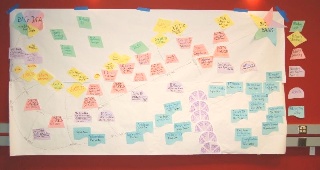Here's one conference I definitely won't miss. I've been lucky enough to preview some of the papers. I gurantee that if you want to deepen your understanding of privacy enhancing technology, you should see if you can get to Cambridge at the end of June:
Robinson College, Cambridge, United Kingdom June 28 – June 30, 2006 http://petworkshop.org/2006/
Special Events:
* Keynote speaker: Susan Landau, Sun Microsystems Laboratories
on “The Missing Link”, (Abstract at the end of the email.)
* PET Award 2006 ceremony and reception at Microsoft Research,
http://petworkshop.org/2006/award.html
Co-located with:
* The Fifth Workshop on the Economics of Information Security
(WEIS 2006), 26-28 June, http://weis2006.econinfosec.org/
* IAVoSS Workshop On Trustworthy Elections (WOTE 2006)
29-30 June, http://www.win.tue.nl/~berry/wote2006/
Privacy and anonymity are increasingly important in the online world. Corporations, governments, and other organizations are realizing and exploiting their power to track users and their behavior, and restricting the ability to publish or retrieve documents. Approaches to not only protecting individuals and groups, but also companies and governments, from such profiling and censorship include decentralization, encryption, distributed trust, and automated policy disclosure.
This 6th workshop addresses the design and realization of such privacy and anti-censorship services for the Internet and other communication networks by bringing together anonymity and privacy experts from around the world to discuss recent advances and new perspectives.
Early registration by May 12 at:
http://petworkshop.org/2006/petRegister.html
Further local information on accommodation and travel is available on the PET workshop website (book accommodation early!):
http://petworkshop.org/2006/petTravel.html
Program Chairs:
* Philippe Golle, PARC
(Philippe.Golle at parc com)
* George Danezis, K.U.Leuven
(George.Danezis at esat kuleuven be)
General Chair:
* Richard Clayton, University of Cambridge
(Richard.Clayton at cl cam ac uk)
Research Program:
(also at http://petworkshop.org/2006/program.html)
Privacy and the real world
* One Big File Is Not Enough: A Critical Evaluation of
the Dominant Free-Space Sanitization Technique
Simson Garfinkel and David Malan
* Protecting Privacy with the MPEG-21 IPMP Framework
Nicholas Paul Sheppard and Reihaneh Safavi-Naini
* Privacy for Public Transportation
Thomas S. Heydt-Benjamin, Hee-Jin Chae, Benessa Defend, and Kevin Fu
* Privacy Rights Management – Taming Cellphone Cameras
Mina Deng, Lothar Fritsch and Klaus Kursawe
* Ignoring the Great Firewall of China
Richard Clayton, Steven J. Murdoch and Robert N. M. Watson
* I Know What You Did Last Summer: Self-Awareness,
Imagined Communities,and Information Sharing in an
Online Social Network
Alessandro Acquisti and Ralph Gross
Privacy policies
* Enhancing Consumer Privacy in the Liberty Alliance
Identity Federation and Web Services Frameworks
Mansour Alsaleh and Carlisle Adams
* Traceable and Automatic Compliance of Privacy
Policies in Federated Digital Identity Management
Anna C. Squicciarini, Abhilasha Bhargav-Spantzel,
Alexei Czeskis and Elisa Bertino
* Privacy Injector – Automated Privacy Enforcement through Aspects
Chris Vanden Berghe and Matthias Schunter
* A Systemic Approach to Automate Privacy Policy
Enforcement in Enterprises
Marco Casassa Mont and Robert Thyne
Anonymous communications
* Improving Sender Anonymity in a Structured Overlay
with Imprecise Routing
Giuseppe Ciaccio
* Selectively Traceable Anonymity
Luis von Ahn, Andrew Bortz, Nicholas Hopper and Kevin O'Neill
* Valet Services: Improving Hidden Servers with a Personal Touch
Lasse Øverlier and Paul Syverson
* Blending different latency traffic with alpha-mixing
Roger Dingledine, Andrei Serjantov and Paul Syverson
Attacks: Traffic and Location analysis
* Breaking the Collusion Detection Mechanism of MorphMix
Parisa Tabriz and Nikita Borisov
* Linking Anonymous Transactions: The Consistent View Attack
Andreas Pashalidis and Bernd Meyer
* Preserving User Location Privacy in Mobile Data
Management Infrastructures
Reynold Cheng, Yu Zhang, Elisa Bertino and Sunil Prabhakar
* Location Access Effects on Trail Re-identification
Bradley Malin and Edoardo Airoldi
Private muti-party computation, authentication, and cryptography
* Private Resource Pairing
Joseph A. Calandrino and Alfred C. Weaver
* On the Security of the Tor Authentication Protocol
Ian Goldberg
* Honest-Verifier Private Disjointness Testing without Random Oracles
Susan Hohenberger and Stephen A. Weis
* A Flexible Framework for Secret Handshakes
Gene Tsudik and Shouhuai Xu
* Optimal Key-Trees for Tree-Based Private Authentication
Levente Buttyan, Tamas Holczer and Istvan Vajda
* Simple and Flexible Private Revocation Checking
John Solis and Gene Tsudik
Keynote speaker:
The Missing Link
Susan Landau
In recent decades, we have seen significant progress in the development of tools to protect privacy. We have similarly seen various policy developments, e.g., the 1980 OECD Guidelines on Privacy Protection and 1997 application to the Internet. But
Between the conception
And the creation
Between the emotion
And the response
Falls the Shadow.
(T.S. Eliot, “The Hollow Men.”)
One shadow is that while privacy policies abound, when data is collected, there are few or no rules governing its security (which is a crucial requirement for data privacy). A current instance of this concerns the recent requirement for data retention by the European Union.
This talk discusses what is needed to get to:
Between the conception
And the creation
Between the emotion
And the response
Falls the Action.




 About two weeks ago I started making a map of the history of the community. This was in part because I knew a lot of new people were coming to the workshop and I wanted to be sure they had some context of who we were and where we had come from. I translated this into an
About two weeks ago I started making a map of the history of the community. This was in part because I knew a lot of new people were coming to the workshop and I wanted to be sure they had some context of who we were and where we had come from. I translated this into an